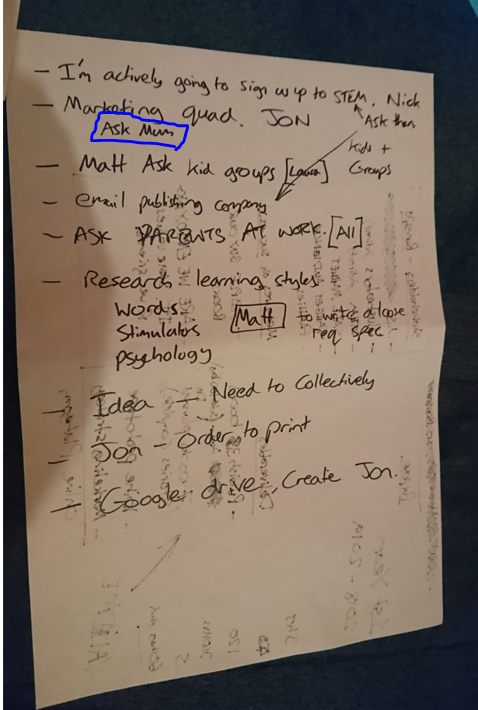Story Time
The picture below summarises the actions we gave ourselves from our last blog, with the main takeaway to come up with the premise of a story in line with Jon’s requirements document. Funnily enough, looking back at this actions list, we are still not sure if we ever ‘asked Mum’ about the marketing quad of aims, and we are all pretty certain that our mums do not know what one is. Maybe they do, who knows. Funny funny but random as hell.
Later that week Nick contacted the guys on a late Tuesday evening explaining that he had a million-dollar idea… What if we had a character who found out by their parents that bees were missing, and went on a journey to figure out why. Initial thoughts were that pesticides and chemicals were tarnishing the lands and that bees were being massacred by mass agricultural industries, however this seemed a little harsh for a children’s story. Think of the children of course, Sorry! So Nick continued to explain that the main character would go on an adventure and meet three animals along the way all affected by the problem; being a lack of flowers. The animals Nick had in mind included a bear with no honey, a hummingbird who was thirsty and a Queen bee who lost her bees because her bees were all distracted up at the arcade playing computer games. The idea would see the bees eating crap food getting over weight, whilst buzzing their faces off on all that fast food sugary goodness because again, there were simply no flowers. It also had some strong undertones for budding parents out there, because shouldn’t the bees be healthy and productive with clear minds, instead of playing computer games all day every day and endlessly drinking fizzy drinks like the current kids of this world…. Anyway, the simple resolution to the problem in the story was that we simply needed to plant more seeds to feed the bees. POW, as simple as that.
Now, both Matt and Jon really didn’t understand why Nick was bouncing off the walls acting like a mad scientist who had a whiteboard for the first time and was frantically writing down ideas, slogans and storyboarding for the rest of the evening. However, both were kind enough to let this crazy energy unravel and liked the basic concept of the story. Afterall, it aligned to earlier ambitions that the reader must be encouraged to do something positive away from the books to help better the environment, and planting seeds to feed the bees rhymed as well ;)
The take away from this mid-week session was it’s better to not state the true facts in a children’s story, where the environmental impacts that contribute to the problems at hand could actually be someone’s phD thesis. Keep it simple! However, we all felt that the story could encourage positive action to help our bees, thus having a positive impact to help better the planet. Result!



